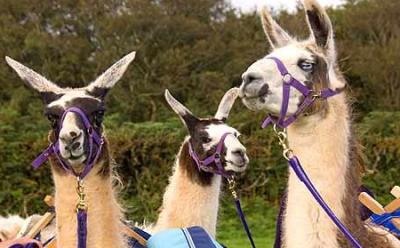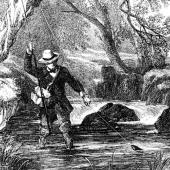Llama Trek at Lone Mountain Ranch
What to do in Montana...
Llamas are strange looking creatures compared to the animals most of us grew up with. They remind me of characters out of a Dr. Seuss book with their big eyes, long lashes, abnormally long skinny necks and sturdy bodies covered in fuzzy wool from head to toe. At first glance, a llama appears as if it would love you to approach and pet its long neck. However, as soon as you reach to touch them, they quickly withdraw.

My first experience with a llama occurred when I was about ten years old. My parents took my younger brother and me to a petting zoo in the Midwest. Before long, my brother and I wandered off and ended up near the llamas. Not realizing that llamas spit (mainly to show dominance or if they feel threatened), my brother and I thought we’d try to feed the shaggy beast some grass and food pellets. Evidentially, this llama didn’t like my brother because when he got too close, the llama let go with full force a big wad of spit packed on the side of his cheek on top of my brother’s head. Now to a couple of young boys who don’t mind getting dirty, llama spit was no big deal. Instead of running to mom and crying, we figured it was time to have some fun. We ran back to my parents and my brother said, “Mom, something fell in my hair, and I don’t know what it is.” Being the good mother, she leaned in and inspected the spit that blended into my brother’s hair. She looked at it, touched it and then she even smelled it. My brother couldn’t hold back any longer, “It’s llama spit!” he said, and we roared with laughter. “Get in the bathroom and clean that up!” scowled my mother with a smile underneath.
A few years ago, I met a woman named Lori Chowning at the Chico Hot Springs Saloon. We were having a drink and getting to know one another. In the process, we found we shared a common interest—backcountry travel. Her favorite mode of travel is the llama. Most of her llama pack trips are through Lone Mountain Ranch in Big Sky. Since then, we often pass each other on the trail in the Spanish Peaks Wilderness Area. She passes us with a little daypack on while we tout forty to fifty pound backpacks. We decided it would be fun to plan a trip together.
After that early llama experience and the fact my parents had never been on a backpacking trip, I wasn’t confident my parents would willingly go on a trek over mountains rising 11,000 feet in the air with llamas. For years, I had been showing my parents photographs of magnificent backpacking trips through Glacier and Yellowstone National Parks and many of the mountain ranges surrounding Bozeman. Loving the outdoors, they also loved to hear about my adventures. I spent most of my growing-up summers in campgrounds around Wisconsin. Now, it was my turn to take them on the adventure of a lifetime. I determined to take them into the backcountry where endless alpine lakes and glorious peaks continuously caress the eyes. However, I wanted them to have the trip of a lifetime, not the last trip of a lifetime. So, I contacted Lori to help with the carrying of food and supplies.
Although initially hesitant, soon their excitement grew. Having already experienced the best of Montana through camping and fly fishing, my parents were ready to take the next step. Their best friends, Bill and Pat, wanted in on the llama trek. So, soon my mom and Pat were on a mission. They determined to carry all of their gear to prove they could do it. “We don’t need llamas,” I remember them saying. Yet, I also knew that if anything went wrong, I would be the one carrying their gear and mine out of the wilderness. Lori and the llamas were coming with us to help out with some of the cumbersome gear and the extra special treats. Still, my mom and Pat decided not to rely on Lori; they determined to train. Imagine two middle-aged ladies walking daily around a suburban neighborhood in the Midwest, wearing stuffed backpacks to get their legs and lungs ready for the big hike.
Out of the many spectacular mountain ranges in Montana, none can compare to the Absaroka-Beartooth Wilderness. To experience the sheer scale and vastness of these mountain ranges, it is necessary to hike or horseback ride into the heart. The trail, adequately named The Beaten Path, is a point-to-point trip that covers twenty-six miles by foot or 100 miles one-way by car. Elevation gains and losses between 3,000 and 5,000 vertical feet, the tallest peak in Montana—Granite Peak and canyons surrounded by sheer granite cliffs rising upwards for thousands of feet awaited us.
After months of planning, we were ready. Three hours outside of Bozeman, we arrived at base camp and broke into two teams. One team shuttled four trucks and one llama trailer from Cooke City 100 miles up and over the spectacular Beartooth Mountains to Rosebud Canyon where our hike would end. In the parking lot, we noticed the worn bumper sticker on the back of Lori’s trailer, “Spit Happens.” I chuckled, remembering my brother’s hair. Lori assured us we were not in danger of being spit on but that sometimes the llamas would spit on each other like a “bunch of rambunctious, antagonizing teens.”
Finally, day one of the trek arrived. We ended up with a total of nine hikers, seven llamas and three dogs. The group consisted of my parents Glenn and Dawn, their friends Bill and Pat, my Uncle Mark and Aunt Cindi from Arizona, Lori, my wife Angi and me. Although the sun shone on this beautiful 60-degree day in early September, I knew a storm could easily roll in and snow on us. We packed for all weather conditions with full-size backpacks. Since the llamas were joining us, we were able to bring luxury items on the trip such as gourmet food, wine, winter boots, a cooking shelter and extra fuel. After a lesson from Lori in proper llama packing, we ate a quick breakfast and hit The Beaten Path.
Wandering among the lodge pole pines while catching glimpses of plateaus and peaks in the distance, our faces beamed. Because llamas overheat, lie down on the trail and go on strike, we could only travel at a certain speed. Consequently, we had lots of time to enjoy the breathtaking views. Just before we reached camp the first day, a member of our group got altitude sickness along with some dehydration. Simultaneously, the weather turned cold and stormy. Then, I wondered if I was in over my head. Fortunately, a horseman from Ennis named Cedar West came to our rescue, helping transport the weakened one to camp where she soon recovered. We celebrated by eating a fabulous dinner of scallops on angel hair pasta served with a wonderful wine.
We awoke the next morning with a blanket of snow covering everything, even the llamas. We were all thankful for the extra cold weather gear. Making the best of it, we cooked breakfast burritos and enjoyed hot coffee. The day warmed and the snow melted while we packed up our gear. Considering the cold air, we still felt good and trekked on to the 11,000-foot mountain pass. The trail climbed slowly leaving the forest behind. Above the tree line the llamas seemed to be even more in their element. Alpine lakes shimmered everywhere, calling us to stop and fish. Upon reaching the pass, we looked back on the spectacular view of the previous ten miles. We were all happy that it was downhill from here. Feeling victorious, we decided to take time to fish and lunch at Fossil Lake on top of Frozen to Death Plateau. My dad caught a 15” cutthroat trout. We then made our way 2,000 feet down the trail to our camp at Twin Outlet Lakes.
Crossing streams and winding down switchbacks, we saw the landscape change from a wide-open plateau into beautiful canyons with large peaks popping out from behind jagged ridgelines. Eventually, we arrived at one of the most beautiful alpine lakes I have ever seen—Dewey Lake. This lake is a surreal turquoise color surrounded by cliffs and ridgelines rising nearly 2,500 feet. Few people enjoy this vista as it lays a minimum of thirteen rugged miles from any trailhead. Camp went up with ease that night. Everyone joined in by unpacking, taking care of the llamas, setting up tents and making dinner. We sat around a cozy fire, eating gourmet appetizers with a main course of Alaskan Salmon, sipping wine and reflecting on the beautiful hike that day.
After a good night’s sleep and another tasty breakfast, it was time to move on. Our Wookey backpacks grew lighter as the llamas’ packs emptied of food and wine. We were really starting to love those llamas! Everyone except my mom, Pat and Bill unloaded gear from their packs, letting the llamas take on the weight. They determined they could pack thirty-five pounds over the twenty-six mile trip, and they did!
We worked our way down the trail again, passing by waterfalls over 300 feet high. We took a quick glance at Granite Peak and even found a fresh bear track on the trail. Fortunately, bears don’t like llamas. So, llamas are a great asset in bear country. Once again, we thanked the llamas.
As our last camp at Rainbow Lake came into view, we crossed paths once again with the horsemen from Ennis. They smiled as they carried fish up from the lake caught using spinning rods. They teased us for fishing the alpine lakes with fly rods, offering us their spinning rods. “No thanks,” we said and headed to the water. To their amazement, we caught fish using our fly rods.
Around the campfire that evening we laughed about the trials of backcountry travel—from the bad weather to altitude sickness and sore muscles, from the lack of a hot shower to the nuisance of hanging food up in bear country. Yet while bemoaning these discomforts, we ate a first-class meal of gourmet venison piccata, drank wine from wine glasses eight miles from the nearest road next to an exquisite, nearly private lake. We were all proud of our accomplishments and thankful for the llamas. They made it possible to bring the “extras” which made the trip comfortable and unforgettable. When planning a backcountry trip like this, remember “Spit Happens.”












Leave a Comment Here